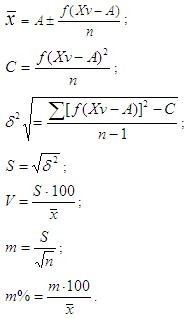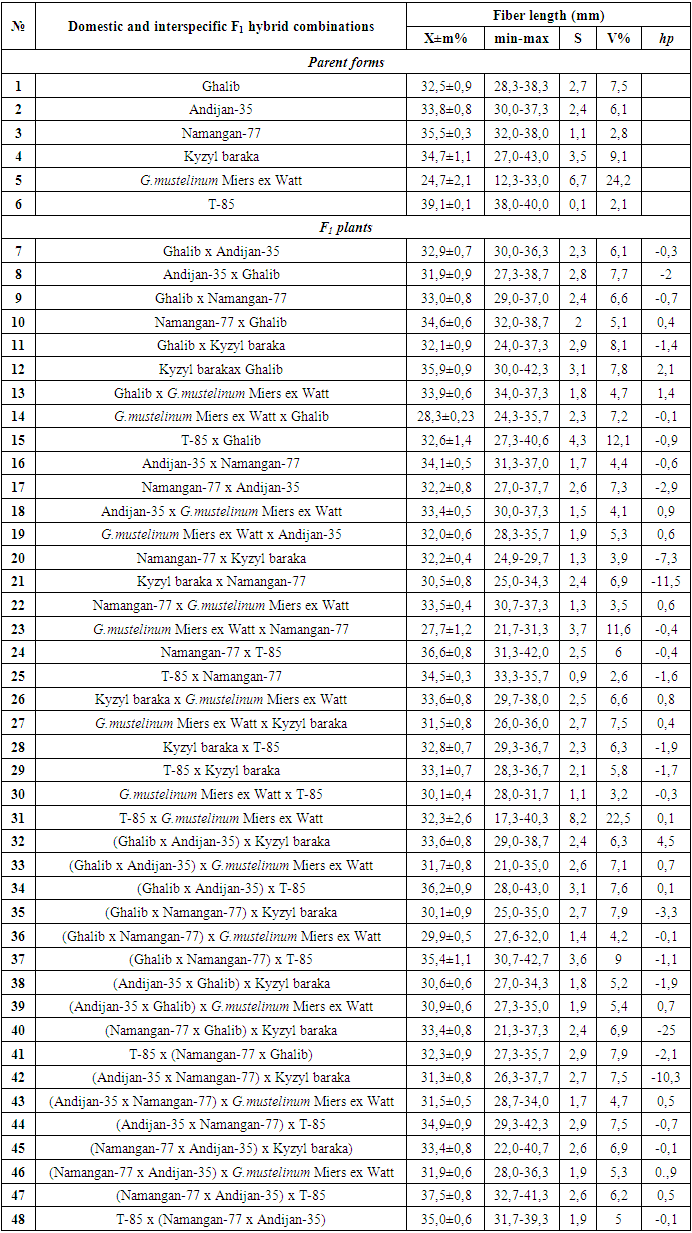-
Paper Information
- Paper Submission
-
Journal Information
- About This Journal
- Editorial Board
- Current Issue
- Archive
- Author Guidelines
- Contact Us
International Journal of Genetic Engineering
p-ISSN: 2167-7239 e-ISSN: 2167-7220
2024; 12(4): 54-58
doi:10.5923/j.ijge.20241204.03
Received: Jun. 17, 2024; Accepted: Jul. 8, 2024; Published: Jul. 10, 2024

Inheritance of Fiber Length in Cotton F1 Hybrids
Abror Mamajonov
Department of Natural sciences, Andjan State University, Andijan, Uzbekistan
Correspondence to: Abror Mamajonov, Department of Natural sciences, Andjan State University, Andijan, Uzbekistan.
| Email: |  |
Copyright © 2024 The Author(s). Published by Scientific & Academic Publishing.
This work is licensed under the Creative Commons Attribution International License (CC BY).
http://creativecommons.org/licenses/by/4.0/

The article presents the results of the research on the heredity, variability and dominance of fiber length in the F1 generation of cotton plants. G.hirsutum cultivars, G.mustelinum wild type and hexoploid T-85 line were crossed and step hybridized. In the inheritance of the fiber length in the F1 generation, the participation of the objects involved in reciprocal hybridization as the father or mother form does not have great importance in the inheritance and formation of the character. Among the F1 hybrids, fiber length is higher in F1 Kyzyl baraka x Ghalib, F1 Namangan-77 x T-85, F1 (Ghalib x Andijan-35) x T-85 and F1 (Namangan-77 x Andijan-35) x T-85 combinations, F1 G.mustelinum Miers ex Watt x Winner, F1 G.mustelinum Miers ex Watt x Namangan-77 and F1 (Ghalib x Namangan-77) x G.mustelinum Miers ex Watt combinations showed relatively low results.
Keywords: Hybrid, Dominant, Heterosis, Allotetraploid, Mutagenesis, Reciprocal and stepwise hybridization
Cite this paper: Abror Mamajonov, Inheritance of Fiber Length in Cotton F1 Hybrids, International Journal of Genetic Engineering, Vol. 12 No. 4, 2024, pp. 54-58. doi: 10.5923/j.ijge.20241204.03.
Article Outline
1. Introduction
- Cotton fiber yield and quality are very important features for cotton fiber processors. Planting cotton varieties with high-quality cotton fiber for arable land is one of the most urgent tasks nowadays. This requirement requires scientists to emphasize scientific work aimed at improving fiber quality [1]. Cotton fiber, a vital component in textile and industrial applications, varies significantly in length depending on genetic factors. Typically, cotton fibers are composed of cellulose and are extracted from the seed husk through ginning processes. The length of these fibers plays a crucial role in their usability and quality for various end products.In the study of cotton fiber characteristics, particularly fiber length, the focus is on understanding how different cotton varieties and their hybrids inherit and manifest this trait. The research highlights the importance of selecting cotton varieties with optimal.Among the varieties studied, observations revealed significant variations in fiber length. For instance, the T-85 line exhibited the longest fibers at 39,1 mm, while the wild type G.mustelinum Miers ex Watt demonstrated shorter fibers at 24,7 mm. Varieties such as Ghalib, Andijan-35, Namangan-77, and Kyzyl baraka showed intermediate lengths ranging from 32,5 mm to 35,5 mm.The study also explored the inheritance patterns of fiber length through reciprocal and stepwise hybridization. Results indicated instances of negative heterosis, where hybrid offspring exhibited shorter fiber lengths compared to their parents, as well as positive heterosis, showing longer fibers. These findings underscore the complex genetic interactions influencing fiber length in cotton hybrids.In conclusion, improving fiber length through selective breeding remains a critical objective for cotton researchers and breeders. The variability observed in fiber length inheritance underscores the need for continued scientific inquiry to enhance cotton varieties that meet the demands of textile.
2. Literature Review
- The authors found that geographically distant medium-fiber cotton species were inherited in F1 hybrids with intermediate, high, and medium positive dominance in fiber length, and positive heterosis results [2].B.A. Sirojidinov studied the inheritance of fiber length in interspecies F1 plants of Indo-Chinese and Australian cotton species and determined that fiber length is passed from generation to generation with positive and negative complete dominance or positive and negative heterosis [3].M.R. Kadirov and others studied the heritability of fiber yield and length by cross-breeding genotypically different forms of G. hirsutum L medium fiber cotton. In the F1 generation, it was noted that this trait is inherited in cases of intermediate, high positive heterosis, medium and high positive dominance [4].Foreign scientists studied fiber length in cotton plant and found that there is a positive correlation between fiber length, strength and fineness [5].F. Killi, L. Efe and S. Mustafayev conducted a scientific study on the genetic and environmental variability of yield and fiber quality in cotton. They noted that 94,6% of heritability of fiber length is accounted for by genes, and the influence of external factors on the formation of this characteristic is small [6].A. Manivannan, V. Wagmarem studied fiber properties by crossing G. arboreum L. species with a diploid set of chromosomes. In the resulting hybrid plants, the average fiber length in the F2 generation is 24,1 mm, the coefficient of variation is 34,3%, and the heritability is 68,8 [7].Al-Ravi and Kokhel published the results of their scientific work on diallel analysis of yield and description of agrotechnical measures in G. hirsutum L-type forms. According to the scientific results obtained by them, it was noted that the length of the fiber is inherited under the influence of polygenes [8].According to the conclusions of I. Umbetayev, Kh. Djumabekov fiber length and productivity in F1 hybrid plants are transmitted to offspring in cases of complete dominance, extreme dominance and heterosis. The results of F2 plants showed that this trait is inherited through polymer genes [9].B.W. Gardunia studies, it has been shown that G.mustelinum species can be used to increase the genetic diversity of cotton and to transfer characters from wild types to elite varieties. G.mustelinum x G.hirsutum F1, F2 and BB1F1 and BB1F2 generations were studied in research. These hybrids were screened for recombination and selection efficiency using microsatellite markers, and introgressive barriers were identified as G.mustelinum species are strongly photoperiod demanding. The characteristics of fiber length, lint weight in per boll are strongly transmitted to the offspring, but a decrease in these parameters was observed in the offspring with G.mustelinum species as the mother [10].It has been proven that fiber length heredity and variation in F1-F4 hybrids obtained from introgressive line crossings can cause drastically different results in hybrids over the years and can also be affected by external environmental factors. It has been confirmed that there is a high possibility of isolating recombinants with a positive set of fiber length markers among F2 - F3 hybrids created with the participation of introgressive cotton lines [11,12].
3. Materials and Methods
- In the experiment, to study the inheritance of fiber length in the F1 generation, in order to study the inheritance of hair weight in varieties belonging to the natural allotetroploid G.hirsutum L. and G.mustelinum L. species (Ghalib, Andijan-35, Namangan-77, Kyzyl baraka), G.mustelinum Miers ex Watt and species with a diploid number of chromosomes (F [6] (Kelajak x (ssp. nanking (white fiber) x G.nelsonii))) obtained allotetroploid by artificial mutagenesis T -85 line was used.The statistical analysis of fiber length of F1, F2 and varieties plants was determined by the method of B.A. Dospekhov [13].
 in which:ƒ- number of repetitions; n – number of plants; A – arbitrary average value; C – additional formula.Dominance levels of F1 plants were calculated using S. Wright’s formula. The fiber length by mathematical processing means the arithmetic mean value (
in which:ƒ- number of repetitions; n – number of plants; A – arbitrary average value; C – additional formula.Dominance levels of F1 plants were calculated using S. Wright’s formula. The fiber length by mathematical processing means the arithmetic mean value ( ), the arithmetic mean error (m), the coefficient of variation (V) and the mean square deviation (S), the accuracy of the experiment (m%) was determined using the following formulas [14].Coefficient of dominant was accounted with following G.M. Beil, R. E. Atkins formula in first link hybrids for traits: hp=(F1-MP)/P-MP; here hp -dominate coefficient;F1- average arithmetic indices of trait in first link;MP- average arithmetic indices of trait of parents’ form;P- average arithmetic indices of best paternal or maternal forms;Trait hereditary were evaluated us follows in first link hybrid: Dominant position not observed (distance) hp = 0; A little dominant 0 < hp < 1; Completely dominant hp = 1; Extremely dominant hp > 1;Breeding coefficient (h2) in F2 combinations was determined by the formula given in the works of Allard (1956) [14].
), the arithmetic mean error (m), the coefficient of variation (V) and the mean square deviation (S), the accuracy of the experiment (m%) was determined using the following formulas [14].Coefficient of dominant was accounted with following G.M. Beil, R. E. Atkins formula in first link hybrids for traits: hp=(F1-MP)/P-MP; here hp -dominate coefficient;F1- average arithmetic indices of trait in first link;MP- average arithmetic indices of trait of parents’ form;P- average arithmetic indices of best paternal or maternal forms;Trait hereditary were evaluated us follows in first link hybrid: Dominant position not observed (distance) hp = 0; A little dominant 0 < hp < 1; Completely dominant hp = 1; Extremely dominant hp > 1;Breeding coefficient (h2) in F2 combinations was determined by the formula given in the works of Allard (1956) [14]. 4. Results and Discussion
- Among the starting materials, the T-85 line showed the highest fiber length of 39,1 mm, while the wild type G.mustelinum Miers ex Watt showed the smallest fiber length of 24,7 mm. The fiber length of Ghalib, Andijan-35, Namangan-77 and Kyzyl baraka varieties was found to be 32,5 mm, 33,8 mm, 35,5 mm and 34,7 mm, respectively. The coefficient of variation (V%) of the samples of the above 4 varieties is shown in table 1. According to this sign, the coefficient of variation of the wild type G.mustelinum Miers ex Watt was high V%=24,2 and low V%=2,1.In both cases, a negative advantage in fiber length was observed in the F1 plants of the Andijan-35 variety, which was reciprocally hybridized with the winning variety. Fiber length (31,9mm) in F1 (Andijan-35 x Ghalib) hybrids, in which Ghalib variety was the parent, was inherited in the state of negative heterosis (hp=-2). In F1 Ghalib x Namangan-77 and F1 Namangan-77 x Ghalib hybrids, fiber length was found to be 33.0mm and 34,6mm, respectively. A strong negative (hp=-0,7) and moderate positive advantage (hp=0,4) was observed in the heritability of the trait. Inheritance through negative and positive heterosis was observed in mutual reciprocal F1 plants of Ghalib and Kyzyl baraka varieties. The same results as above were recorded in the F1 reciprocal hybrids with the participation of another Ghalib variety (Table 1).
|
5. Conclusions
- The fiber length indicators recorded in the F1 generations obtained by reciprocal and step hybridization can basically be concluded as follows;- in the inheritance of the fiber length in the F1 generation, the participation of the objects involved in reciprocal hybridization as the father or mother form does not have great importance in the inheritance and formation of the character;- it was noted that fiber length can be changed in the positive direction in the F1 generation through stepwise crossing.- according to the analysis of the above literature, the level of heredity of fiber length in the F1 generation was found to be inherited as positive and negative weak, medium, strong dominance or showing different levels of heterosis.Among the F1 hybrids, fiber length is higher in F1 Kyzyl baraka x Ghalib, F1 Namangan-77 x T-85, F1 (Ghalib x Andijan-35) x T-85 and F1 (Namangan-77 x Andijan-35) x T-85 combinations, F1 G.mustelinum Miers ex Watt x Winner, F1 G.mustelinum Miers ex Watt x Namangan-77 and F1 (Ghalib x Namangan-77) x G.mustelinum Miers ex Watt combinations showed relatively low results.
 Abstract
Abstract Reference
Reference Full-Text PDF
Full-Text PDF Full-text HTML
Full-text HTML